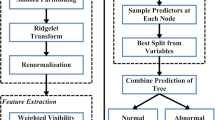Abstract
The neurophysiology system is a complex network of nerves and cells, which carries messages to and from the brain and spinal cord to various parts of the body. Exploring complexity of the system can be contributed to understand diverse neurophysiological abnormalities, which may further result in different kinds of neurological disorders. In this paper, we present a novel analyzing framework to characterize the complexity of neurophysiological system, under which a specific weighted FPE-complexity-based feature (W-FPE-F) is extracted from EEG and then applied into the automated epileptic seizure detection. Combining with extreme learning machine (ELM) and support vector machine (SVM), performances of the proposed method are finally verified on two open EEG databases. Simulation results show that the proposed method does a good job in detecting the epileptic seizure, particularly, it is able to avoid the undesirable detection performance caused by individual divergence effectively.





Similar content being viewed by others
References
Song J-L, Zhang R (2016) Automatic seizure detection using a novel eeg feature based on nonlinear complexity. In: 2016 international joint conference on neural networks (IJCNN), pp 1686–1693
de la Torre-Luque A, Bornas X, Balle M, Fiol-Veny A (2016) Complexity and nonlinear biomarkers in emotional disorders: a meta-analytic study. Neurosci Biobehav Rev 68:410422
Yoshimura M, Isotani T, Yagyu T, Irisawa S, Yoshida T, Sugiyama M (2004) Global approach to multichannel electroencephalogram analysis for diagnosis and clinical evaluation in mild alzheimer’s disease. Neuropsychobiology 49:163–166
Fernandez A, Quintero J, Hornero R, Zuluaga P, Navas M, Gomez C, Escudero J, Garca-Campos N, Ortiz JBT (2009) Complexity analysis of spontaneous brain activity in attention-deficit/hyperactivity disorder: Diagnostic implications. Biol Psychiatry 65:571–577
Lee SH, Choo J, Im W, Chae J (2008) Nonlinear analysis of electroencephalogram in schizophrenia patients with persistent auditory hallucination. Psychiatry Invest 5:115–120
Song Y, Crowcroft J, Zhang J (2012) Automated epileptic seizure detection in EEGs based on optimized sample entropy and extreme learning machine. J Neurosci Methods 210:132–146
Nicolaou N, Georgiou J (2012) Detection of epileptic electroencephalogram based on permutation entropy and support vector machines. Expert Syst Appl 39:202–209
Acharya UR, Molinari F, Subbhuraam VS, Chattopadhyay S (2012) Automated diagnosis of epileptic EEG using entropies. Biomed Signal Process Control 7:401–408
Kumar Y, Dewal ML, Anand RS (2014) Epileptic seizure detection using DWT based fuzzy approximate entropy and support vector machine. Neurocomputing 133:271–279
Grassberger P, Procaccia I (1983) Characterization of strange attractors. Phys Rev Lett 50:346–349
Wackermann J (1996) Beyond mapping: estimating complexity of multichannel eeg recordings. Acta Neurobiol Exp 56:197–208
Tononi G, Sporns O, Edelman G (1994) A measure for brain complexity: relating functional segregation and integration in the nervous system. Proc Natl Acad Sci USA 91:5033–5037
Hsu K-C, Yu SN (2010) Detection of seizures in eeg using subband nonlinear parameters and genetic algorithm. Comput Biol Med 40:823–830
Pincus SM, Gladstone IM, Ehrenkranz RA (1991) A regularity statistic for medical data analysis. J Clin Monit Comput 7:335–345
Song JL, Hu WF, Zhang R (2016) Automated detection of epileptic EEGs using a novel fusion feature and extreme learning machine. Neurocomputing 175:383–391
Li S, Zhou W, Yuan Q, Geng S, Cai D (2013) Feature extraction and recognition of ictal EEG using EMD and SVM. Comput Biol Med 43:807–816
Zhang Y, Zhou W, Yuan S, Yuan Q (2015) Seizure detection method based on fractal dimension and gradient boosting. Eoilepsy Behav 43:30–38
Majumdar K (2012), Differential operator in seizure detection. Comput Biol Med 42:70–74
Zhang X, Wang T, Liang X, ao F, Li Y (2012) A class-based feature weighting method for text classification. J Comput Inf Syst 3:965–972
Wang Q, Ye Y, Huang J (2008) Fuzzy k-means with variable weighting in high dimensional data analysis. In: Proceedings of web-age information management, pp 365–372
Wang L, Wang J (2012) Feature weighting fuzzy clustering integrating rough sets and shadowed sets. Int J Pattern Recognit Artif Intell 26:1769–1776
Gunes S, Polat K (2010) Efficient sleep stage recognition system based on eeg signal using k-means clustering based feature weighting. Expert Syst Appl 37:7922–7928
Shoeb AH. Application of machine learning to epileptic seizure onset detection and treatment. Phd thesis, Massachusetts Institute of Technology
Chen L-L, Zhang J, Zou J-Z, Zhao C-J, Wang G-S (2014) A framework on wavelet-based nonlinear features and extreme learning machine for epileptic seizure detection. Biomed Signal Process Control 10:1–10
Wang X, Cao W, Non-iterative approaches in training feed-forward neural networks and their applications. Soft Computing. https://doi.org/10.1007/s00500-018-3203-0
Weipeng Cao X, Wang Z, Ming J, Gao (2018) A review on neural networks with random weights. Neurocomputing 275:278–287
Yuan Q, Zhou W, Li S, Cai D (2011) Epileptic EEG classification based on extreme learning machine and nonlinear features. Epilepsy Res 96:29–38
Song J-L, Zhang R (2017) Application of extreme learning machine to epileptic seizure detection based on lagged poincare plots. Multidimension Syst Signal Process 28:945–959
Siuly, YLi, Wen (2011) Clustering technique-based least square support vector machine for EEG signal classification. Comput Meth Prog Biomed 104:358–372
Xizhao Wang R, Wang C, Xu (2018) Discovering the relationship between generalization and uncertainty by incorporating complexity of classification. IEEE Trans Cybern 48:703–715
Acknowledgements
This work was supported by the National Natural Science Foundation of China under Grant 61473223 and the Natural Science Foundation of Shaanxi Province, China under Grant 2017JM1043.
Author information
Authors and Affiliations
Corresponding author
Additional information
Publisher’s Note
Springer Nature remains neutral with regard to jurisdictional claims in published maps and institutional affiliations.
Rights and permissions
About this article
Cite this article
Zhang, SL., Zhang, B., Su, YL. et al. A novel EEG-complexity-based feature and its application on the epileptic seizure detection. Int. J. Mach. Learn. & Cyber. 10, 3339–3348 (2019). https://doi.org/10.1007/s13042-019-00921-w
Received:
Accepted:
Published:
Issue Date:
DOI: https://doi.org/10.1007/s13042-019-00921-w




